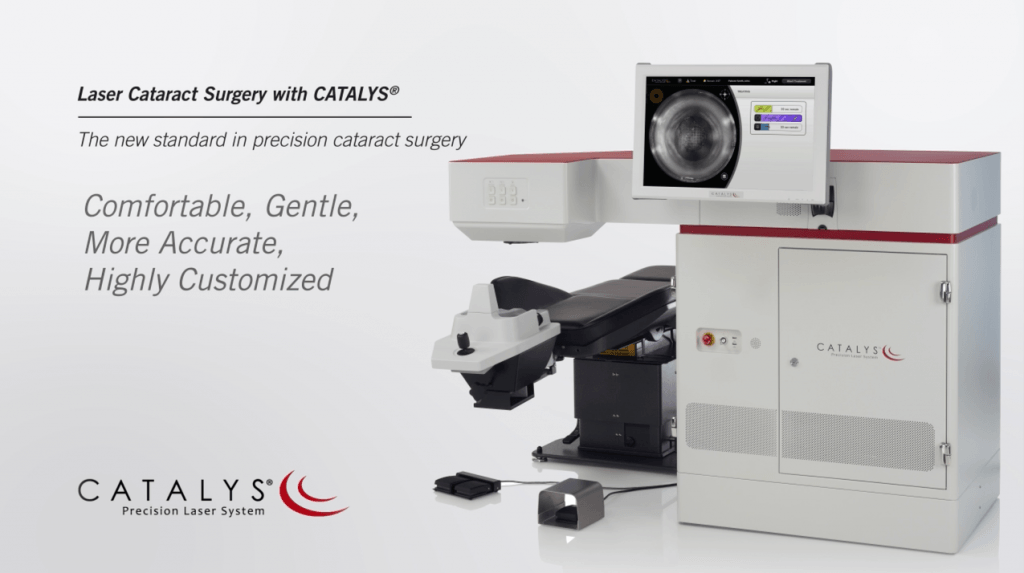nJoy Vision has become the first eye-care services provider in Oklahoma to offer cataract surgery with the Catalys® Precision Laser System. Catalys combines a state-of-the-art femtosecond laser, advanced 3D Optical Coherence Tomography (OCT) imaging, sophisticated software and a host of other unique features that enable surgeons to provide patients a gentle, highly customized procedure with unprecedented precision.
“It is a privilege to have the technology available for increased precision for our cataract patients. We have included the laser cataract as part of our upgraded vision packages and we look forward to offering patients this advanced technology,” said Brad Britton, M.D., Medical Director, nJoy Vision and President, CEO BVA.
A cataract is a common condition in which the lens of the eye becomes progressively cloudy, making vision fuzzy and normal daily living activities more difficult. Cataract surgery is the only treatment for cataracts and is one of the most widely performed procedures worldwide, estimated at 19 million cases per year.1
In the traditional (non-laser) approach, the surgeon must perform several critical steps using handheld instruments. This manual approach limits predictability and precision, potentially affecting visual outcomes and complication rates. In recent years, femtosecond laser and 3D imaging technology have been incorporated into cataract surgery to enhance the precision, accuracy and customization of the procedure. The Catalys Precision Laser System represents the new standard in the field and has been shown in clinical study to deliver precision that is unequaled in the industry.2,3
Using Catalys, surgeons can access and remove the cataract with accuracy that is approximately 10 times greater than that achieved with manual technique.2,3 This precision and accuracy sets the stage for the proper positioning of the artificial replacement lens. In addition, Catalys’ sophisticated laser technology makes break-up and removal of the cataract easier and gentler on the patient.4 A clinical study has shown that Catalys nearly or completely eliminates the ultrasound energy traditionally needed during this step. This low-energy approach reduces inflammation, with more rapid recovery expected.4,5
Depending on the patient’s pre-operative vision and desired visual result, nJoy Vision surgeons may recommend a tailored treatment plan that could include creating ultra-precise laser incisions in the cornea and a specific lens type, such as a multi-focal lens for near and far vision. This tailored treatment may reduce the need for glasses or contacts after surgery.
Laser treatment with Catalys takes approximately three minutes and causes little or no discomfort to patients.
“I am pleased with the softening ability of the laser to allow us to utilize much less ultrasound energy in the removal of the cataract,” said Dr. Britton.
The Catalys Precision Laser System was developed by OptiMedica® Corp. (Sunnyvale, Calif., USA) in close collaboration with a Medical Advisory Board of cataract experts from around the world. Catalys was CE mark approved in August 2011 and market cleared by the U.S. Food and Drug Administration in December 2011. The system is available at leading ophthalmology practices around the world, including nJoy Vision.
References
1 2011 Market Scope Report on the Global Cataract Equipment Market
2 Friedman, NJ, et al., “Femtosecond Laser Capsulotomy,” Journal of Cataract & Refractive Surgery, 2011 July; 37(7): 1189-1198
3 Palanker, D., et al., “Femtosecond Laser-Assisted Cataract Surgery with Integrated Optical Coherence Tomography,” Science Translational Medicine, Vol 2 Issue 58: 1-9 (2010)
4 Dick, B. “The synergy of MICS and femtosecond lasers: the future of small incision cataract surgery,” Ophthalmology Times Europe, 2012 April; Vol 8 Issue 3
5 Burkhard HD., “Femtosecond cataract surgery outcomes: an advance or not?” Proceedings from the XXX Congress of the European Society of Cataract and Refractive Surgery in Milan, Italy. September 2012.


Leave a Reply